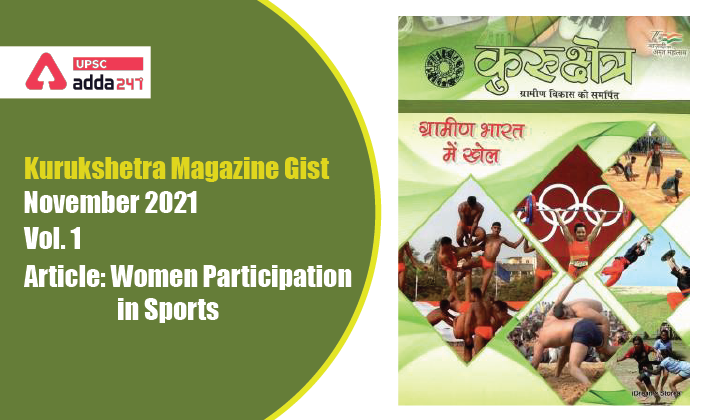Table of Contents
Context
India is one of the countries that have profited the most from the surge in female athletes in the Tokyo Olympics.
Background
India had sent its biggest-ever contingent to Tokyo Olympics with 126 athletes across 18 sports, out of which there were 54 female athletes.
History of Indian Women Participation in Olympics
- The very first year that Indian women made the journey to the Olympic Games happened in the 1924 Paris Olympics when two women athletes from India took part.
- The four subsequent editions of the Games saw nil participation from Indian women spanning two decades – 1928 to 1948.
- A contingent comprising of 60 men and women represented India in the 1952 Summer’ Olympic Games held in Helsinki.
- By the 1980 Moscow Games Indian women became a regular feature of the Olympic entourage and their numbers kept growing steadily.
- 54 in the 2016 Rio Olympics: Interestingly, the Rio Games saw almost equal participation of men and women from India as the men athletes outnumbered the women only by 9 more members.
Women who excelled in other games
- Apart from achieving success at Olympic games, women are attaining new heights in other games too.
- The achievements of Sania Mirza in Tennis, Mithali Raj in Cricket, Phogat sisters in wrestling, Deepika Kumari in Archery, Bula Chaudhary in swimming are noteworthy and inspiring young talents.
Inspirational Women Athletes of India
- T. Usha(Athlete)- Her 102 medals won at national and international tournaments created a sensation in the country and motivated a generation of young women athletes.
- Karnam Malleswari – the first Indian woman who won a bronze medal in the 2000 Sydney Olympics in women’s 69 kg category in weightlifting.
- Mary Kom(Boxing) and Saina Nehwal(Badminton) – Bronze Medal in London Olympics in 2012
- P.V. Sindhu(Badminton) – Silver medal in badminton
- Sakshi Malik(Wrestling) – Bronze medal in wrestling in 2016 Rio Olympics
- Women Athletes in Tokyo 2020: P. V. Sindhu, Saikhom Mirabai Chanu and Lovlina Borgohain made India proud by winning medals and have clearly shown the positive change that is taking place in our country. While, Saikhom Mirabai Chanu won the Silver medal at the very first day of the Tokyo Olympics 2020, P.V. Sindhu became the first Indian women to win two Olympic medals. She won the Silver medal in Rio 2016 and in Tokyo 2020 she captured the Bronze medal. Also, Lovlina Borgohain achieved her first Olympic medal in Women’s welterweight 64-69 kg.
Historical Policies and Programmes to Promote Sports in India
- India Council of Sports (AICS)(1954)
- Ministry of Sport (now the Ministry of Youth Affairs and Sport, MYAS)(1982)
- National Sports Policy and the Sports Authority of India (SAI) was set up(1984)
- the Netaji Subhas National Institute of Sport (NSNIS) and the Lakshmibai National College of Physical Education (LNCPE) were introduced in 1986.
- National sports policy(2001) was introduced with a dual aim of mass participation in sport and excellence at the elite level.
- National Sports Development Code of India 2011, aimed to implement new strategies to achieve objectives set by the previous policies.
Present Policies and Programmes to Promote Sports in India
At present, Ministry of Youth Affairs and Sports is running the following schemes to promote sports in the country, including rural, tribal and backward areas: –
(i) Khelo India Scheme;
(ii) Assistance to National Sports Federations;
(iii) Special Awards to Winners in International sports events and their Coaches;
(iv) National Sports Awards, Pension to Meritorious Sports Persons;
(v) Pandit Deendayal Upadhyay National Sports Welfare Fund;
(Vi} National Sports Development Fund; and
(vii) Running Sports Training Centres through Sports Authority of India.
Challenges for Women in Sports
- Socio-cultural issues
- Access to Facilities and Safety Issues
- Lack of Systemic Interventions and Resources
- Lack of Awareness Among the Masses
How Sports can help in imparting gender equality?
- Sport in its most basic form encourages balanced participation and has the capacity to promote gender equality (SDG Goal 5: Achieve gender equality and empower all Achieve women and girls)
- Through sport and physical activity, women and girls can be empowered and benefit from the constructive impact that sport has on health and psychosocial conditions.
Conclusion
Sports in India is in the process of development. To accelerate this rate of development, a holistic approach should be adopted. Efforts are required in developing infrastructure, identifying sports talents, organising regular sports events, and generating awareness at the grass-root level.



 TSPSC Group 1 Question Paper 2024, Downl...
TSPSC Group 1 Question Paper 2024, Downl...
 TSPSC Group 1 Answer key 2024 Out, Downl...
TSPSC Group 1 Answer key 2024 Out, Downl...
 UPSC Prelims 2024 Question Paper, Downlo...
UPSC Prelims 2024 Question Paper, Downlo...





